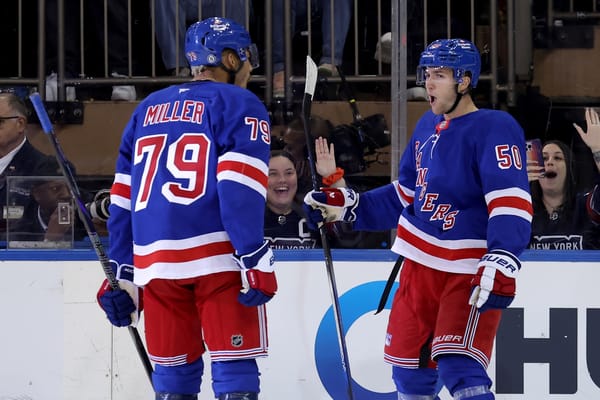Jimmy Vesey Has Had Fine Start to the Season
Jimmy Vesey is among Ranger leaders in a few offensive categories, and has had a positive impact with his most frequent linemates.
At the 28-game mark of the season, Jimmy Vesey has nine goals and five assists for 14 points. He is ranked second and fifth among all New York Rangers in those respective categories and is half way to reaching his career high total in points. If Vesey were to keep pace, he would finish the year with 26 and 15 assists and 41 points and all would be career bests. I don’t expect him to do so, but at the very least he should tie or exceed his production from last season.
Vesey has been one player who has showed improvement under rookie bench boss David Quinn, and it’s worth looking into what has led to Vesey’s improvement. Is it deployment, who he is playing with, or could it just be the case of a player being more comfortable in their third season?
This year Vesey has logged 370:34 at even strength. In that time, his most popular linemate has been Brett Howden, with his second, third and fourth most popular linemates being Jesper Fast, Ryan Strome and Pavel Buchnevich.
The line of Vesey-Howden-Fast has logged 70:25 together, and has a Corsi differential of -3 (48.84 CF% | +4.49 relative), a goal differential of 1 (57.14 GF% | +4.42 Rel), and an expected goals differential of 0.02 (50.17 xGF% | 4.6 Rel). But their PDO of 105.68 stands out in this small sample.
The Vesey-Howden-Strome line has been together for 58:42, an even smaller sample, and its stat line includes a Corsi differential of -37 (33.91 CF% | -9.98 Rel), a goal differential of -2 (25 GF% | -43% Rel), and an expected goals differential of -2.58 (26.71 xGF% | -19.15 Rel). The “good?” thing about this line is its PDO of 98.9 which indicates an element of unluckiness.
At this point you might be saying, “I see all these numbers, but what the f#*! do they mean?” When you dig deeper, it becomes clear that Vesey has been a somewhat positive player individually, and he’s helped prop up one of his linemates. He’s also found some chemistry and success with a linemate, and both could be even more dangerous with the right center acting as a trigger man.
Together, Howden and Vesey’s CF% is 43.77, their GF% is 47.06. their SCF% is 40.23 and their PDO is 102.5. When Vesey has been away from Howden, his CF% improves nearly three percent to 46.75, his GF% shoots up to 54.55, and his scoring chances for percentage increases to 45.39. His PDO of 101.8 is just above neutral territory. Howden, on the other hand, has been a worse player without Vesey. His numbers include a 40.77 CF%, a 46.67 GF%, a scoring chances for percentage of 38.19, and a PDO of 102.4 away from the winger.
When you take into account that Howden is a rookie, this predicament isn’t that all surprising. In many respects, Howden has been the forward equivalent of Neal Pionk, a dazzling player from a counting stats perspective while being dismal from an underlying numbers perspective. The NHL is very much a “what have you done for me lately?” league, and there are and will continue to be players like that. The goal at times is finding a suitable partner or linemate who can help round out the edges. Howden has produced with four goals and nine assists for 13 points in 28 games, and could just be scratching the surface. Pairing him with a player like Vesey and Fast was a good decision by Quinn, and the results speak for themselves.
The key theme here is that Howden has struggled a bit without one or both of his frequent linemates, and he’s negatively impacted his linemates singularly and collectively. That shows by Vesey and Fast’s individual numbers, and their numbers together as a duo.
Vesey and Fast have spent 51:37 together away from Howden and are sporting a CF% of 54.55, a GF% of 66.67 and a SCF% of 54.55 with a PDO of 95. This duo was recently promoted to the top line to flank Mika Zibanejad due to injuries and it makes sense given their underlying numbers. That trio has only seen 30:46 together, and thus far has a CF% of 56.10, a GF% of 0, a SCF% of 63.16 and a PDO of 92.3 This line could be broken up soon, as Pavel Buchnevich and Mats Zuccarello could potentially return to the lineup on Saturday.
With all of that said, it is nice to see that Vesey is having individual success in addition to helping a linemate. Of his nine goals, six of them have come 5v5, as have four of his five assists. Three of those four have been primary helpers so in total nine of his 10 points 5v5 have been primary. If Vesey were exceeding his prior rates by cashing in on the power play, there would be reason to be cautious when looking at future projections.
At this point last year, the former Harvard Crimson winger had five goals and four helpers for nine points. Vesey would pick up his 14th point of the season, on a goal, during Game 36 vs. the Toronto Maple Leafs. His ninth goal of the season came five games later in a victory over the Arizona Coyotes. From an underlying numbers perspective, Vesey had a Corsi for percentage of 46.03 at 5-on-5, a goals for percentage of 41.18, and a scoring chances for percentage of just 46.29. His PDO at the time was 98.1 which was a combination of a 8.24 shooting percentage and .898 save percentage. In short, Vesey was slightly unlucky, and he should have had more to show for his efforts.
Over the remaining 51 games played, Vesey’s Corsi was worse at 44.73 percent, his goals for percentage of 44.44 was slightly up, and his scoring chances for was down to 45.08. During this stretch his PDO was a 101.2. He scored eight more goals, and added four assists for 12 points the rest of the way. His total 2017-18 line included 17 goals and 11 assists for 28 points, and he was fifth in total goals and tenth in points.
Going forward it would be great if Vesey is able to keep up his level of play, which could change how he is perceived as a player. His underlying numbers are in line with what he’s done since joining the Rangers, but his tangible results have improve. He pretty much is what he is at this point, and his ceiling could be that of a 40-point player. Vesey deserves some credit for how he’s played, the impact he’s had on Howden and the collective success he’s had with Fast.
There is no telling how he will perform the rest of the way, but a positive to consider is that he is relatively free of red flags that indicate he’s drastically playing above his potential.
Stats via Corsica and Natural Stat Trick unless otherwise noted.





